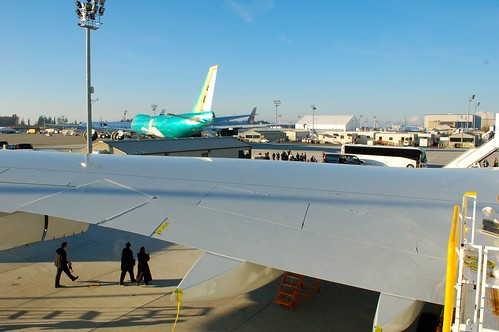FARNBOROUGH -- Since its first flight in February, Boeing's 747-8F flight test program has
completed roughly a third of its 1600h flight test campaign, though steady momentum has been elusive, as the new jumbo freighter has encountered one time consuming technical issue after another.
The sum of three main issues, including two more recent ones, have eaten Boeing's remaining margin, causing Boeing Commercial Airplanes president and CEO, Jim Albaugh, to caution that "The entry into service could slip into 2011."
With the
landing gear door flap vibration issue now resolved, flight test challenges have given way to troubleshooting two primary issues.
The first centers on the aircraft's inboard ailerons and the power control unit that drives them. Boeing found that when a pilot makes a slow input on the jumbo jet's controls the high pressures in the hydraulic system cause an oscillation, requiring a fix in the actuator, according to two 747-8 program sources.
Apture™

by Jon Ostrower
The second, the freighter was found to encounter a structural flutter at mid-weight near cruise speed, requiring engineers to dampen out the aeroelastic vibration. Options for resolution include adding structure to the wing or potentially developing a new control law to avoid the condition.
RC501, the lead flight test aircraft based at Boeing Field in Seattle, has for the last month and a half has been dedicated to trouble-shooting both issues. Programme sources say the company aims to complete resolution on the flutter issue by the close of the month.
Boeing declined to address the specific issues encountered by the program, though the company continues to caution that while first delivery to Cargolux remains "at risk", certification is remains targeted for year end, adding:
The 747-8 Freighter flight test development program is a dynamic process of performance demonstration, validation and issue identification and resolution. To date, we've flown approximately 550 hours and completed substantial airworthiness, aerodynamic performance and systems testing. Over the course of testing, technical issues are discovered and resolved. As we advance toward completion of flight testing, fewer and fewer discoveries are expected. As we have previously demonstrated, when an issue arises, we address it immediately.
With five months to go in that goal, Boeing's remaining flight test margin is virtually gone, with the company's Flight Operations, Test & Validation organization looking for ways to find - or create - contingency where available. Boeing has already opted to grow its flight test fleet from three to four, with the addition of RC503, which may fly before the week is out, heading immediately into high intensity radiated field (HIRF) testing in Arizona.
Compared to its composite stablemate the 787, which has progressed more swiftly through its flight test campaign, 747-8F has struggled to find its footing along side the company's flagship program. While still technically a derivative aircraft of the 747 family, the aircraft's all-new fly-by-wire wing,
engines and
avionics, make it a significantly different aircraft from the variants that preceded it.






 by Jon Ostrower
by Jon Ostrower